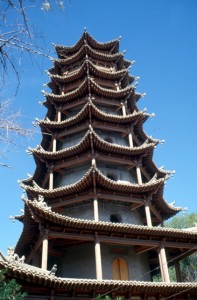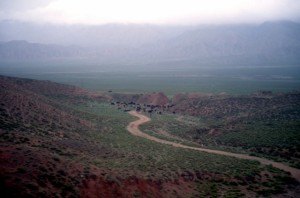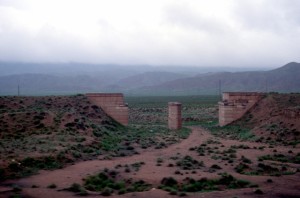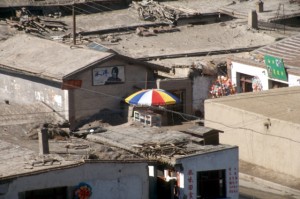By train from Lanzhou to Zhanye, with views from the train window, and from our fellow passengers.
Returning to Lanzhou, we booked into a hotel near the railway station, as we planned an earlier departure the next day. As so often in Chinese hotels, we got numerous calls during the night, with offers of massage. Now there are genuine massage people in China, but when they call you at eleven at night, you can bet that you are dealing with prostitutes. Usually, unplugging the telephone will put an end to the offerings, but in this case we had a knock on the door, five minutes after we unplugged the telephone after another unsolicited call. Even with my wife answering the door, they did not get the message.
The train to Zhanye, our next destination, left at 9.45 in the morning. The first stop at any station was only 6 1/2 hours later, at 15.15. In between, there were no stations worth stopping at for this so-called express train. So-called, as the average speed is probably not more than 30-40 km per hour. I now understand why trains in China can be so punctual: it cannot be difficult to make up lost time with these kinds of speeds, and very few stops only. The route to Zhanye runs through the Hexi corridor, a narrow valley with the high mountains of the Tibetan massif to the south and another range to the north. It is obvious why the Silk Route passed here, and nowhere else.
The further west one gets, the less vegetation one sees; the landscape becomes more desert-like. At a certain point the train follows parts of the Great Wall, except that the wall is not so great here, anymore, rather a crumbling mud ramp with the occasional gate in it. The scenery is probably quite spectacular on a clear day, but when it is raining, everything looks grey. We passed the occasional nameless town in the distance, with nondescript mud-huts in the outskirts, 4-5 story buildings further inside (so that you don’t need lifts) and the 20 story building in the centre. Every self-respecting Chinese town nowadays must have a high-rise status symbol, preferably with white tiles and blue-tinted glass, a flashy entrance to mask the fact that most of the building has not yet been finished, and, if possible, a revolving restaurant on the top floor.
We got to talk to our companions in the compartment, and to a whole lot of other people, too, who drifted in and out during the long journey, curious about these foreigners. Our best friends were an army officer, who was on his way to Urumchi in Xinjiang Autonomous Region, and a business man from Guandong, the rich southern province in China. Conversation was slow, of course, between their limited English and our, even more limited, Chinese. The favourite sentence of the soldier was that the sun rises in the east and sets in the west, all in English. Mind you, I would not be able to say the same in Chinese. Towards the end of the trip the army officer brought up the issue of Tibet, and the issue of Xinjiang. He could not understand why so many countries were making such a fuss about Tibet, he was convinced that most Tibetans wanted to be part of China, and just in case one doubts, he had talked to a friend of his, who lived in Llassa, and who had told him so. Friend was also working in the army, just like he was. And he also disapproved of terrorist activities of the Xinjiang separatists, he firmly believed that it would be better to talk, to negotiate, instead of using violence. He seemed genuinely convinced about these issues, and we did not have the heart, and the language skills, to explain about right of self-determination, freedom of speech, and the unlikely prospect of negotiating these things with the Chinese authorities.
Continue: In Zhanye













